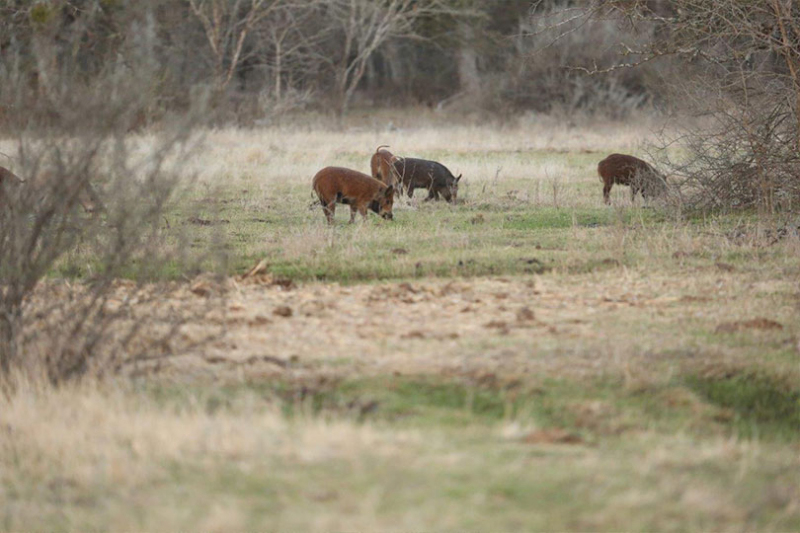By Jessica Domel
Multimedia Reporter
Texas landowners will soon have another tool to aid in the control of the ever-growing feral hog population.
The Texas Parks and Wildlife Commission approved a proposal that allows aerial wildlife permit holders to use unmanned aerial vehicles (UAVs), or drones, to track feral hogs at night to help hunters on the ground.
“The availability of both UAVs and thermal cameras to the general public has increased significantly over the last few years. The use of these products can be very effective in the control of feral hogs and the damage associated with their depredation, particularly at night when they’re most active,” Stormy King, assistant commander of wildlife enforcement at the Texas Parks and Wildlife Department (TPWD), said.
Hunting exotics or wildlife from drones remains illegal at any time.
“The amendments proposed by staff would specifically allow the use of UAVs to locate feral hogs at night for take by gunners on the ground. The amendments would not allow the take from any drone mounted weapons systems, nor would they apply to any other species,” King said.
Prior to the commission’s Nov. 3 vote, TPWD accepted comments from the public on the proposal.
Of the 65 who commented, 51% were in complete agreement, 37% completely disagreed and 12% disagreed on a specific issue.
“The most common comments in opposition, which were germane to the proposal, mentioned concerns that it would legalize the use of drone mounted weapons systems, and that it would increase the likelihood of overflight over others’ property to hunt with drones. In reality, the proposal limits the use of UAVs to the location of feral hogs for take by gunners on the ground and explicitly prohibits any means of take from the UAV itself,” King said.
As to the overflight concerns, King said there are provisions that limit overflight while someone is conducting a permitted activity under an aerial wildlife management permit. There are no such restrictions applicable to UAVs in general.
The department also received several comments addressing concerns with fair chase and hunting ethics.
According to the Texas Administrative Code, TPWD may issue an aerial wildlife management permit to any person if the department find that management by the use of aircraft, which now includes drones, is necessary to protect land, water, wildlife, livestock, domesticated animals, human life or crops and will not have a harmful effect on indigenous species.
When applying for a permit, the person must submit landowner authorization to use a drone or other aerial device to control wildlife or exotic animals. They must also explain why the permit should be issued.
Prior to this most recent change, the administrative code only allowed Texans to use hot air balloons and/or helicopters to fatally control feral hogs. King said that’s because that part of the code was written because drones weren’t as popular, or readily available to the public, when the code was written.
“Under our state regulations, it’s illegal to conduct take activity under our area wildlife management permit between 30 minutes after sunset and 30 minutes before sunrise. We’re strictly trying to allow folks to be able to use these drones for a good purpose, and it requires a rule change for it to technically be legal,” King said.
The federal Airborne Hunting Act prohibits shooting, attempting to shoot or intentionally harassing any bird, fish or other animal from an aircraft except for certain specified reasons, including protection of wildlife, livestock and human health, except as is provided by state law. In Texas, TPWD sets regulations for regulating airborne wildlife management. While it may be legal to hunt feral swine from helicopters and hot air balloons, the change approved by the commission only allows drone operators with the aerial wildlife management permit to track feral hogs. It’s up to hunters on the ground to fatally control them.
In Texas, feral hogs are invasive. They root up the soil to find food, and since there are millions of them, cause millions of dollars in damages each year to crops, pastures, golf courses, landscaping and cemeteries.
They can also contaminate fresh water sources and compete with native wildlife for natural resources.
Since feral swine can reproduce every three months, three weeks and three days, their populations continue to grow.
They’re such a problem in Texas that as of 2019, a valid hunting license is no longer needed to hunt feral hogs on private property. Landowner consent is required.
Transporting live feral hogs remains unlawful unless it is done so in compliance with Texas Animal Health Commission regulations.
The new drone rule is expected to go into effect before the end of the year.


I am concerned about the need to comply with FAA Part 107 that restricts night flying of ‘drone’ and the same part requires actual visibility of the UAS aircraft which is commonly limited to less than 1500 feet. Aircraft lighting is not a substitute for visibility. I expect the FAA will take a much stronger position on this.